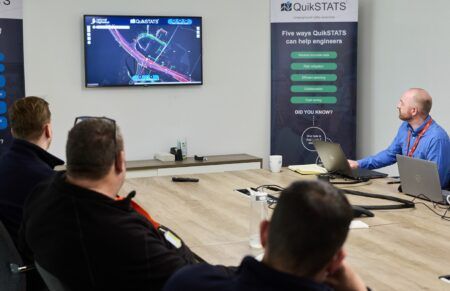The ConVeX (Connected Vehicle to Everything of Tomorrow) consortium has completed Europe’s first live demonstration of C-V2X (cellular-vehicle-to-everything) direct communication interoperability between a motorcycle, vehicles and roadside infrastructure.
The ConVeX consortium comprises Audi, Ducati, Ericsson, Swarco, the Technical University of Kaiserslautern, and Qualcomm CDMA Technologies (a subsidiary of Qualcomm Inc.), and was formed last year to carry out the first announced C-V2X trial based upon the 3rd Generation Partnership Project’s (3GPP) Release 14.
The group’s latest demonstration took place near Ingolstadt in Germany, and featured Audi Q7 and A4 road vehicles, as well as a Ducati Multistrada motorcycle, all equipped with C-V2X technology using the Qualcomm 9150 C-V2X chipset. The showcase demonstrated common situations that can take place between motorcycles and vehicles, and how C-V2X technology can be used to improve road safety.
The scenarios included Intersection Collision Warning, where a vehicle equipped with C-V2X technology pulls out from a junction with an adjoining road and avoids hitting a motorcycle rider who has the right of way, as well as Across Traffic Turn Collision Risk Warning, in which a vehicle avoids a left turn collision with a motorcycle. These use cases are part of a wider set of advanced applications that have been demonstrated through the ConVeX project, which also involves vehicle-to-infrastructure (V2I) communication using roadside infrastructure units developed by Swarco, and vehicle-to-network (V2N) communication using Ericsson’s 4G/5G cellular test network operated at the section of A9 motorway that forms Germany’s digital testbed.
The consortium is co-funded by the participating organizations and the German Federal Ministry of Transportation and Digital Infrastructure (BMVI), within the scope of its ‘Automated and Connected Driving on Digital Test Fields in Germany’ program. As a part of the ConVeX consortium’s ongoing efforts to support the commercial deployment of C-V2X technology, the group will continue to conduct field trials throughout the year to demonstrate the benefits of using a unified cellular-based connectivity platform to showcase range, reliability and latency advantages for real-time C-V2X direct communications. The goal is to highlight new use cases that are expected to help support traffic flow optimization, improve road safety, and pave the path toward automated driving.
During the trials, C-V2X direct communications for vehicle-to-vehicle (V2V), V2I, and vehicle-to-pedestrian (V2P) scenarios operate over the 5.9GHz ITS spectrum without the need for a Subscriber Identity Module (SIM), cellular subscription or network assistance.
Complementing direct communication transmissions, network-based communications are designed to use the wireless operator’s 4G and emerging 5G wireless networks for V2N communication and operate over licensed operator spectrum to support telematics, connected infotainment, and a growing variety of advanced informational safety use cases. V2N scenarios for the trials operate on Ericsson’s 4G and 5G test network in Germany in the cellular 2.6GHz band.
“We are convinced that with our connected car technology we can contribute to more safety on the roads,” said Stefan Koetz, chairman of Ericsson. “This is why we are currently focusing on 5G-based mobility solutions like C-V2X, whether in test series like the ConVeX trials or large-scale test fields, such as the 5G Connected Mobility testbed on the A9.”
July 5, 2018




